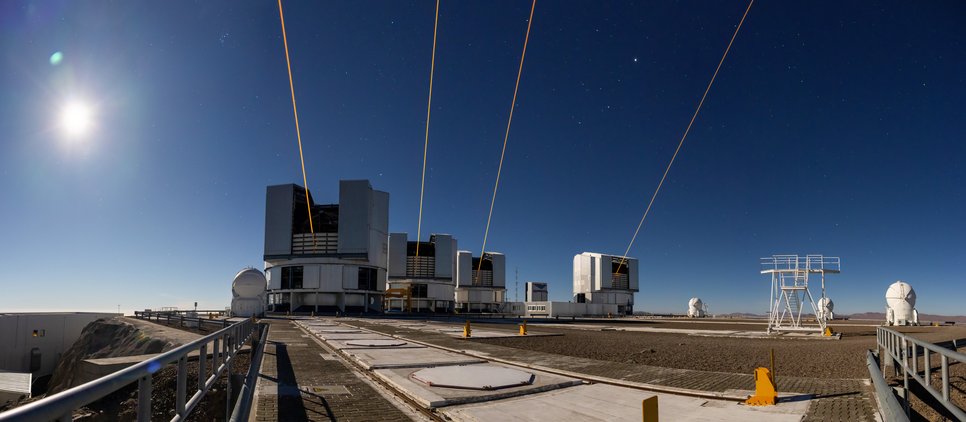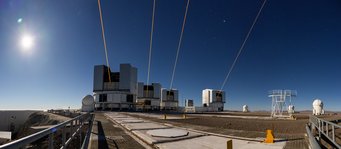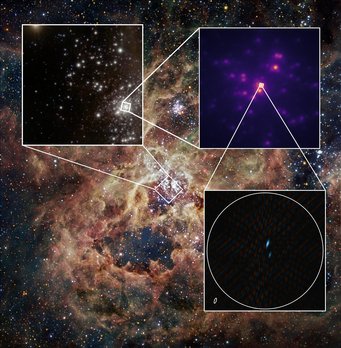The dawn of a new era in interferometry: successful testing of the GRAVITY+ lasers at the VLTI
A few days ago, the Very Large Telescope Interferometer (VLTI) at the European Southern Observatory (ESO) in Chile succeeded for the first time in using four lasers to create artificial stars in the upper atmosphere, enabling the four 8-meter telescopes of the VLTI to perform outstandingly sharp observations of the sky. The lasers are part of the GRAVITY+ upgrade of the VLT interferometer. This upgrade also increases the sensitivity of the system by a factor of 10 and makes it possible to study celestial objects at virtually any point in the sky.

In theory, it would be quite simple: the larger the diameter of a telescope, the sharper the details that can be resolved and the fainter the objects that can be observed. However, unlike telescopes in space such as the Hubble Space Telescope, telescopes on the ground always have to look through our Earth's atmosphere, which blurs images due to its layers and turbulence. Depending on the severity of the disturbances, astronomers refer to good or poor seeing. However, even with excellent seeing at the world's best atmospheric sites, such as ESO's Paranal Observatory in Chile, telescopes normally never come close to achieving their technically possible image sharpness. But this can be corrected with what is known as adaptive optics. This technique involves continuously analyzing the disturbances in image sharpness using reference stars in the field of view of the actual target object, e.g., a galaxy, and using this information to control deformable mirrors in the beam path in real time. These adaptive mirrors then generate corrections that counteract the distortions caused by the atmosphere, resulting in sharp images.
But there is a problem: very often there are no suitable comparison stars near an object of scientific interest. This is where special lasers come in, which can be used to create artificial stars at an altitude of about 90 km in Earth´s atmosphere, which then enable the adaptive optics to make the correction. This means that, in principle, an unlimited number of objects can be explored at any point in the sky.

The background image is a wide-field view of the Tarantula nebula taken with the 1.5 Danish telescope at ESO’s La Silla Observatory. The first inset shows a closeup of the central stellar cluster obtained with ESO’s Very Large Telescope at Paranal Observatory. We then see an even closer look taken with the GRAVITY+ acquisition camera, and finally the binary star itself. The small ellipse in this last inset represents the resolution of GRAVITY+.
If you have several telescopes equipped with adaptive optics and such lasers, they can be interconnected and the resolution further increases thanks to the now even larger diameter of the overall arrangement. At the VLTI, this process, known as Interferometry, is achieved by combining all four 8-meter telescopes or four additional smaller telescopes.
"As part of the GRAVITY+ upgrade of the VLTI, laser operation has now been enabled on all four 8-meter telescopes, making it possible to observe any celestial object with interferometry at a previously unattainable level of quality. This milestone makes the VLTI a globally unique interferometer," says Laura Kreidberg, director at MPIA and Co-I in GRAVITY+.
The complex GRAVITY+ upgrade during the last years includes not only the lasers, but also improvements to the detectors and adaptive mirror systems. The VLTI can now not only be used at any point in the sky, but is also 10 times more sensitive.
In previous years, the VLTI has already delivered outstanding observational results with the original GRAVITY system. These included, for example, observations of the environment of the massive black hole at the center of our Milky Way galaxy and of exoplanets. But with GRAVITY+, not only many more objects can be observed, but above all, much fainter and distant targets. This means that also objects such as active galaxies from the early universe, at large light-travel distances of billions of light-years, are now within reach.
A few days ago, the famous Tarantula Nebula/30 Doradus – a star-forming region in our neighboring galaxy, the Large Magellanic Cloud – was targeted as the first test object. With these observations, a star with an estimated mass more than 150 times the mass of our Sun in the Tarantula Nebula that had previously been interpreted as a bright single star was revealed to be a double star – and this at a light travel distance of more than 160,000 light-years from Earth.
GRAVITY+ is being built by a consortium consisting of MPE, INSU/CNRS, the University of Cologne, MPIA, CENTRA, the University of Southampton, and the associated partner KU Leuven, in close collaboration with ESO.
Further information about GRAVITY+, additional images and, above all, videos, as well as a detailed list of the partners involved can be found in the original ESO press release.
KJ

